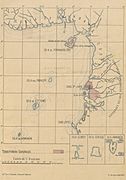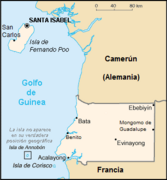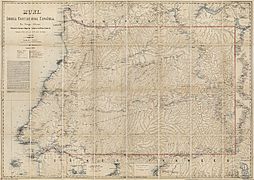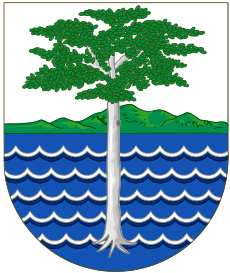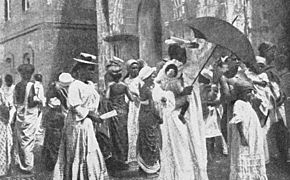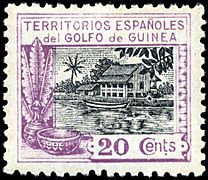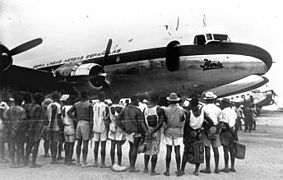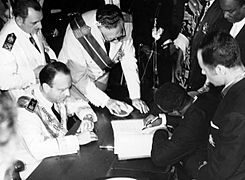Spanish Guinea facts for kids
Quick facts for kids
Spanish Territories on the Gulf of Guinea
Territorios españoles en Golfo de Guinea (Spanish)
|
|||||||||||||
|---|---|---|---|---|---|---|---|---|---|---|---|---|---|
| 1778–1968 | |||||||||||||
|
|
|||||||||||||
|
Anthem: Marcha Real (1844–1873, 1874–1931, 1942–1968)
Himno de Riego (1873–1874, 1931–1942) |
|||||||||||||
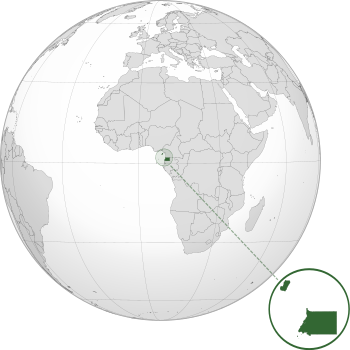
Location of Spanish Guinea in central Africa.
|
|||||||||||||
| Status | Union of Spanish colonies (1858–1926) Colony of Spain (1926–1956) Province of Spain (1956–1968) |
||||||||||||
| Capital | Santa Isabel | ||||||||||||
| Common languages | Spanish (official) Annobonese Creole Pichinglis Fang |
||||||||||||
| Religion | Roman Catholicism | ||||||||||||
| Government | Spanish colonial government | ||||||||||||
| Head of State | |||||||||||||
|
• 1844–1868 (first)
|
Isabella II | ||||||||||||
|
• 1936–1968 (last)
|
Caudillo Francisco Franco | ||||||||||||
| Governor-General | |||||||||||||
|
• 1858–1859 (first)
|
Carlos Chacon y Michelina | ||||||||||||
|
• 1966–1968 (last)
|
Víctor Suances Díaz del Río | ||||||||||||
| Historical era | New Imperialism, World War I, World War II, Cold War | ||||||||||||
|
• Established
|
11 March 1778 | ||||||||||||
|
• Spanish take possession of Fernado Po. Administered as part of the Viceroyalty of the Río de la Plata
|
1778 | ||||||||||||
|
• Spanish evacuate Fernado Po
|
1780 | ||||||||||||
|
• Spanish sovereignty reasserted over Fernando Po
|
1844 | ||||||||||||
|
• Protectorate established over Rio Muni
|
1885 | ||||||||||||
|
• Administrative union of the various colonies
|
1926 | ||||||||||||
| 12 October 1968 | |||||||||||||
| Currency | Spanish peseta | ||||||||||||
|
|||||||||||||
| Today part of | Equatorial Guinea | ||||||||||||
Spanish Guinea (in Spanish: Guinea Española) was a group of islands and mainland areas controlled by Spain. These territories were located in Central Africa, near the Gulf of Guinea and the Bight of Bonny. Spain ruled these lands starting in 1778. In 1968, Spanish Guinea became an independent country called Equatorial Guinea.
Contents
History of Spanish Guinea
Early Days: 18th and 19th Centuries
Spain officially created its colony in the Guinea region in 1778. This happened through a deal with Portugal called the Treaty of El Pardo. From 1778 to 1810, Spain managed this territory from its colonial center in Buenos Aires, which is now in Argentina.
Later, from 1827 to 1843, the United Kingdom used the island of Bioko as a base. They were trying to stop the illegal slave trade that was still happening. In 1843, Britain moved its base to Sierra Leone. The next year, in 1844, Spain took back control. The area then became known as the "Spanish Territories of the Gulf of Guinea."
The 20th Century and Land Changes
Spain had never fully settled the large area it claimed in the Bight of Biafra. Over time, France expanded its own territories, taking land that Spain had claimed. By a new agreement in Paris in 1900, Spain was left with a smaller mainland area called Río Muni. This area was about 26,000 square kilometers, much smaller than the 300,000 square kilometers Spain had once claimed.
- Some maps of Spanish Guinea
-
Spanish possessions in the Gulf of Guinea in 1897.
-
Spanish Guinea after Treaty of Paris of 1900.
-
Río Muni, the mainland part of Spanish Guinea, in 1903.
Farming and Workers
In the late 1800s, farmers from Spain, Portugal, Germany, and the local Fernandino community started growing large amounts of cacao on Fernando Po island. Many of the local Bubi people had died from diseases or forced labor. Because of this, the island needed workers from other places.
A deal was made with Liberia in 1914 to bring in up to 15,000 workers by sea. A German shipping company helped with this. However, in 1930, an international group (ILO) found that Liberian workers were being recruited under very harsh conditions, almost like forced labor. So, the government stopped Liberian workers from going to Spanish Guinea.
There was still a shortage of workers for cacao, coffee, and logging. This led to many Igbo and Ibibio workers from Nigeria being smuggled in by canoe. By 1942, about 20,000 hidden workers were on Fernando Po. Spain then signed a new agreement with the British in the same year. This led to a steady flow of Nigerian workers to Spanish Guinea. By 1968, when the country became independent, nearly 100,000 Nigerians lived and worked there.
The Colony of Spanish Guinea

Between 1926 and 1959, Spain combined Bioko island and Río Muni into one "colony of Spanish Guinea." The economy relied on growing cacao and coffee on big farms, and also on logging. The companies that owned these farms and logging operations hired mostly workers from other countries like Liberia, Nigeria, and Cameroon.
Spain also carried out military actions in the 1920s to control the local Fang people. By 1926, Spain had set up military posts of the Colonial Guard all over the area. By 1929, the whole colony was considered "peaceful."
Río Muni had a small population, officially just over 100,000 in the 1930s. People could easily cross the borders into Cameroon or Gabon. Also, the logging companies needed more and more workers. Growing coffee also gave people another way to pay taxes.
Fernando Po island continued to need more workers. France only allowed recruitment from Cameroon for a short time. So, farmers started to recruit Igbo workers who were secretly brought in canoes from Calabar, Nigeria. After World War II, Fernando Po became one of Africa's most productive farming areas.
- Pictures of Spanish Guinea
-
Corisco in 1910.
Becoming Independent
After World War II, the political history of Spanish Guinea had three main stages. From 1946 to 1959, it was called a "province" instead of a "colony." In 1959, the colony was split into two provinces: Rio Muni and Fernando Po. From 1960 to 1968, Spain tried to give the provinces some self-rule, hoping they would stay connected to Spain. But this didn't work because people in Guinea kept pushing for full independence.
Finally, on October 12, 1968, Spain granted independence to the Republic of Equatorial Guinea. Francisco Macías Nguema was elected as the first president.
- Independence of Spanish Guinea
People of the Colony
The population of Spanish Guinea was organized into different groups. This system was similar to what was found in French, English, and Portuguese colonies in Africa:
- Peninsulares — These were white Spanish people whose move to the colony was controlled by the Spanish government.
- Emancipados — These were Black African people who had adopted Spanish culture through Catholic education. Some were descendants of formerly enslaved people from Cuba who returned to Africa. This group also included mestizos (people of mixed local and European heritage) and mulattoes (people of mixed African and European heritage) who were recognized by a white Spanish father.
- Fernandinos — These were Creole peoples, meaning they had mixed ethnic backgrounds. They often spoke a local form of Pidgin English on Fernando Po island (now called Bioko).
- "Individuals of colour" under patronage — This group included most of the local Black African people. It also included mestizos and mulattoes who were not recognized by white fathers and had been sent from the Americas. The main local groups in Guinea were the Bubi and Bantu peoples like the Fang of Rio Muni.
- Others — This group mainly included people from Nigeria, Cameroon, China, and India who were hired as contract workers.
See also
 In Spanish: Guinea española para niños
In Spanish: Guinea española para niños
- Dominican Spanish
- Afro-Dominicans
- White Dominicans
- Dominican Americans
- Washington Heights, Manhattan
- Alfonso XII
- Royal Palace of Madrid
- Spanish immigration to Cuba
- Captaincy General of Cuba
- Spanish Sahara
- Spanish protectorate in Morocco




